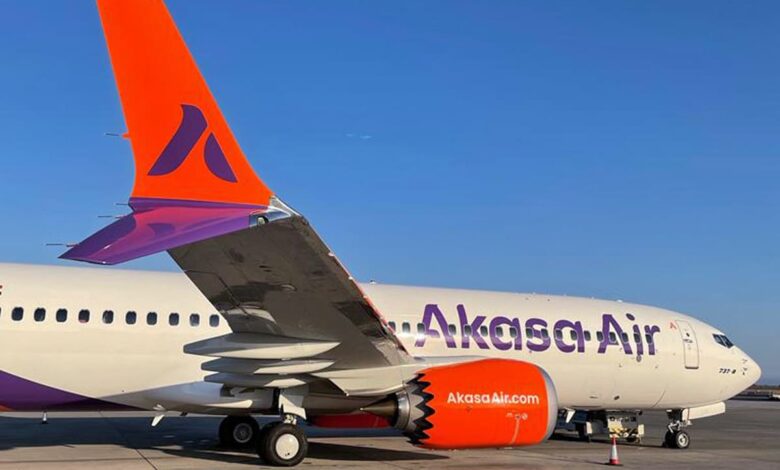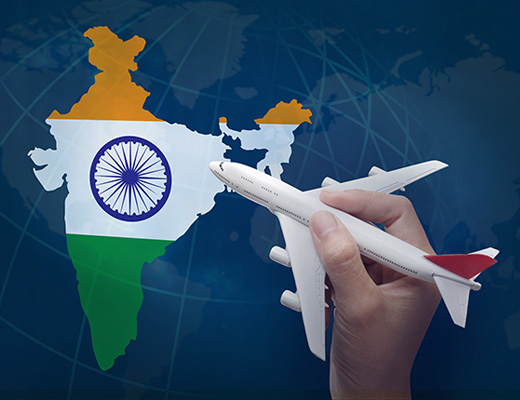Akasa Air Orders 150 Boeing MAX Jets, Eyeing Overseas Operations; What Is The Outlook For The Aviation Industry In 2024 Despite The Many Misses And DGCA Overhauling Many Airlines
Eyeing international horizons, Akasa Air recently announced an order for 150 Boeing 737 MAX narrowbody planes. The development comes amidst challenges faced by Boeing's MAX jetliner program, including a recent mid-air cabin panel incident in the United States. Despite challenges, India's aviation sector is set to soar to new heights. With a glimpse into the past year's impressive passenger numbers and a forecast of over 225 million travellers, 2024 unfolds with promising prospects - factors such as strong yields, metropolitan dominance, and evolving travel patterns come to the forefront, offering a comprehensive perspective on what lies ahead for the aviation sector.

India’s Akasa Air has placed an order for 150 Boeing 737 MAX narrowbody planes, marking a significant move to expand its operations beyond domestic routes in the world’s fastest-growing aviation market.
The announcement comes as Boeing’s MAX jetliner program faced challenges, including a mid-air cabin panel blowout in the U.S. earlier this month.
Although the terms of the deal were not disclosed, Akasa anticipates the delivery of the aircraft over the next eight years. The order, which includes the 737 MAX 10 and MAX 8-200 variants, was unveiled at the “Wings India” air show in Hyderabad, emphasizing a growing interest in international routes.
The deal comes despite the recent setback in the MAX jetliner program due to the cabin panel incident. The country’s civil aviation minister, Jyotiraditya Scindia, predicts a surge in the fleet size from the current 700 to 2,000 over the next decade, reflecting the robust growth in travel demand.

While international traffic remains largely dominated by global carriers like Emirates, Indian airlines, including IndiGo, Air India, and Akasa, have pending orders for over 1,500 planes, reflecting a substantial investment in the industry.
Akasa, which started operations in 2022, has quickly gained a 4% market share, positioning itself as a noteworthy player. However, its larger competitor, IndiGo, holds the lion’s share with 60%, and Tata Group airlines collectively command a 26% market share.
Currently operating domestically with a fleet of about two dozen planes, Akasa aims to overcome previous challenges, such as the abrupt departure of a tenth of its pilots last year, which impacted its market share. The airline now looks ahead to international expansion and increased market presence.
Anticipating A Sky-High Year
As we peer into the future of Indian aviation, 2024 appears poised to emerge as a landmark year.
Preliminary estimates suggest that over 150 million domestic and 68 million international passengers took to the skies in 2023, setting the stage for a robust total air passenger traffic forecasted to exceed 225 million in the upcoming year.
The aviation sector in India is characterized by strong yields, driven by a confluence of factors such as consolidation within the airline sector, the significant vulnerability of competitors, and challenges in the Original Equipment Manufacturer (OEM) supply chain.
This unique situation has created a scenario where robust demand is chasing after limited supply.
While the industry is bathed in euphoria, certain factors, including input costs, VISA processing times, operational hurdles, and international competition, could temper the overall optimism.

Domestic Travel – Metro Dominance Continues
In 2024, domestic travel is expected to maintain its stronghold in the six metropolitan cities of Delhi, Mumbai, Bengaluru, Chennai, Hyderabad, and Kolkata. Collectively, these cities contribute to over 55% of all passengers, with Delhi leading the pack, followed by Mumbai and Bengaluru.
Economy class passengers are set to dominate the skies, with business and premium economy jointly accounting for less than 5% of total travel demand.
Notably, Tier 2 and Tier 3 cities are anticipated to witness a rise in premium demand and associated bookings. Following the patterns observed in 2023, cities like Kochi, Lucknow, Bhubaneshwar, Srinagar, and Udaipur experienced consistent demand for premium offerings, including business class and premium economy, throughout the year.
The inclusion of new destinations such as Ayodhya into domestic networks and expanded airport capacities in Goa, Port Blair, and Tiruchirappalli promise an improved travel experience for domestic travelers, albeit at a potentially higher cost. As India’s aviation sector continues to evolve, the outlook for air travel in 2024 appears exceedingly promising.

As of now, the premium air travel segment in India is primarily dominated by Vistara and Air India, the two airlines offering business class services.
The competition for capturing the premium market share remains contingent on scheduling, and it’s noteworthy that both these carriers are entities within the Tata group, set to merge, potentially paving the way for a new domestic competitor with a similar premium offering.
Indigo, concluding 2023 with an impressive market share exceeding 60%, is expected to maintain its dominance in the airline market throughout 2024. Following closely are the Tata-owned airlines, Air India, Vistara, and AIX Connect (formerly AirAsia India), collectively holding a 26% market share.
However, challenges persist in the aviation sector, including supply chain disruptions affecting Original Equipment Manufacturers (OEMs), engine issues with Pratt and Whitney engines, the ongoing insolvency of GoFirst, and the fragility of SpiceJet.
These challenges contribute to an anticipated variance of nearly 150 aircraft from planned capacity. Yet, this capacity shortfall is projected to bolster strong yields, especially in the backdrop of an election year and an expected resurgence in travel demand.
In international travel, the Middle East and North America are forecasted to be significant revenue drivers. The Middle East is set to maintain its dominance, attracting up to 47% of all international traffic originating from India, with Dubai leading the way with 12% – 14% of the share.
Factors like VISA policies, hotel capacity, costs, and event growth have aligned favorably for Dubai, distinguishing it from destinations like London and Singapore.
Looking ahead, Indigo and Tata-owned airlines, along with the introduction of Akasa’s international operations, are expected to enhance their international networks.
SpiceJet, in response, plans to introduce its own offerings. Air India will continue to refine its offerings, and there is speculation about Indigo’s newer aircraft adopting a dual configuration to cater to premium demand.
The evolving dynamics suggests a dynamic and competitive year in the international travel sector.

International Travel Pie
Examining the distribution of air traffic across continents and considering projections for 2024, Europe is anticipated to remain under the dominance of London, attracting up to 30% of the traffic originating in India and heading towards Europe.
Following closely is Paris, capturing 10% of the traffic bound for Europe. In the United States, New York is poised to continue its dominance, along with San Francisco, each securing a 10% share of the Indian-originating traffic destined for the USA.
Emerging cities like Dallas, with a growing Indian diaspora population, are likely to be integrated into airline networks.
For South East Asia, Singapore and Bangkok are projected to maintain their dominance in attracting India-originating traffic, with Singapore commanding 30% and Bangkok approximately 22%.
Similarly, Vietnam and Nepal are expected to continue drawing significant traffic due to a combination of pricing, policies, and popularity.
When examining overseas hubs and traffic originating in India connecting via these hubs, Dubai is expected to lead, followed by Doha and Abu Dhabi. The majority of the connecting traffic through these hubs has traditionally been bound for North America.
The limitations of European hubs in handling traffic originating from India are gradually becoming evident. With Air India focusing on an international strategy that circumvents hubs and Indigo expanding point-to-point international flights, the share of India-originating traffic flown by Indian carriers is poised to rise.

Premium Air Travel
Turning to the premium segment, a fascinating yet perplexing aspect of air travel demand, particularly in the domestic sector where it remains relatively small.
AT-TV estimates that premium demand (including premium economy) constitutes less than 5% of total demand. However, due to its pricing dynamics and revenue impact, this segment cannot be overlooked.
In the international segment, premium demand is expected to be route-specific, constituting less than 10% of total demand on a capacity basis but exceeding 15% on particular routes.
The potential in this segment necessitates airlines to develop and position products tailored for this purpose. In 2024, as Air India expands its product offerings, a competitive response from international airlines is inevitable.
This competitive landscape will also witness enhancements to frequent flyer programs, complimentary offerings, and a focus on the growing premium economy segment.
The Last Bit, the aviation outlook for India in 2024 is marked by dynamic shifts and promising developments across various facets of the industry.
With a robust forecast of over 225 million passengers, the domestic market appears poised for a significant surge, driven by factors such as strong yields, consolidation within the airline sector, and supply chain challenges.
Despite challenges in capacity, including OEM supply chain disruptions and the insolvency of certain carriers, the anticipated variance in aircraft capacity is likely to contribute to sustained strong yields, particularly in an election year with a projected return of travel demand.
On the international front, traffic patterns reveal a continued dominance of the Middle East in terms of Indian-originating international travel, with Dubai, Doha, and Abu Dhabi leading the way. Europe remains under the stronghold of London, while emerging cities like Dallas may find a place in airline networks.




